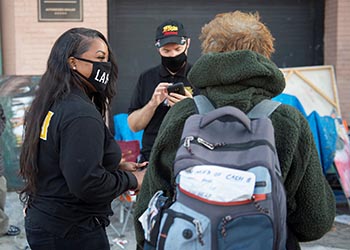- By:
- Category: Homeless and High-Needs

Photo credit: Mayra Beltran Vasquez/County of Los Angeles.
POLICY BRIEF: Serious Mental Illness among People who are Unsheltered in Los Angeles ![]()
TECHNICAL APPENDIX: Serious Mental Illness among People who are Unsheltered in Los Angeles ![]()
PRESS RELEASE: New Research Sheds Light on Prevalence of Serious Mental Illness Among Unsheltered L.A. Residents Enrolled in Street Outreach Services
In Los Angeles, 45,021 people experiencing unsheltered homelessness received street outreach services between July 1, 2019 and June 30, 2020. Supporting and housing unsheltered residents is an urgent priority in Los Angeles, and it is imperative to better understand the challenges that individuals are facing. However, questions persist about the size and unique needs of the group of individuals who are unsheltered and diagnosed with a serious mental illness (SMI).
To better understand the prevalence of psychotic spectrum disorders (“PSD”) among those who are unsheltered, the California Policy Lab (CPL) linked homeless outreach service records found in the Los Angeles Homeless Services Authority’s (LAHSA) Homeless Management Information System (HMIS) to service records at the LA County Department of Mental Health (DMH) and the LA County Department of Health Services (DHS). We used the linked data to estimate the number of people who are enrolled in a street outreach program and who had a service visit for serious mental illness (“SMI”) in the five years prior to their street outreach enrollment. We then stratified this group into two distinct groups: those with service visits with a diagnosis of PSD and those with service visits with a diagnosis of a serious mental illness without psychotic symptoms (“Other SMI”). We analyzed these data to show how many people in these groups were enrolled in interim or permanent housing within one year of their enrollment in street outreach services, and we break down interim and permanent housing enrollments by race and ethnicity. Our analysis also shows how many street outreach participants did not have service records for PSD or Other SMI within the five years prior to enrolling in street outreach.
Select Media Coverage
LAist: CARE Court Has Been Live For Weeks in LA and OC. How’s It Going? (Jan 12, 2024)
Key Finding 1:
Ten percent of individuals (4,584) had a DMH or DHS service for a psychotic spectrum disorder diagnosis within 5 years prior to enrollment in street outreach. Another 7.3% of individuals (3,277) had a service for another SMI (“Other SMI”) within 5 years prior to enrollment in street outreach. Overall, 17% of people had an SMI service within 5 years prior to enrollment in street outreach. The vast majority (83%) of street outreach participants do not have a County service history with a diagnosis for any serious mental illness in the five years before enrolling in Street Outreach services.
Figure: Street Outreach Participants with a Service involving Psychotic Spectrum Disorder or Other SMI within 5 Years Prior to Street Outreach Enrollment
Key Finding 2:
About 20% of street outreach participants enrolled in interim or permanent housing within a year of starting street outreach. Forty percent of participants with a PSD diagnosis enrolled in interim or permanent housing, including 33.5% who enrolled in Interim Housing and 6.1% who enrolled in either Rapid Re-housing or Permanent Supportive Housing.
Figure: Rate of Interim and Permanent Housing Enrollments of Participants with Services involving Psychotic Spectrum Disorder, Other SMI, and No SMI
Key Finding 3:
Participants with services for PSD are more likely to be Black, less likely to be Hispanic, and slightly less likely to be White compared to participants with services for Other SMI and those with No SMI. Those with services for PSD are 65% male compared to 51% male for those with Other SMI services, and 67% male for those with No SMI.
Table: Demographics and Prior Homeless Service History of Street Outreach Participants with Past PSD or Other SMI Services Compared to No SMI
Key Finding 4:
Eighty percent of participants with services for PSD have prior contact with any homeless services compared to 75% for those with services for Other SMI and 31% for participants with No SMI.
###
Editor's note: More about the photo on this page: LAHSA’S Homeless Engagement Team members Donnese Smith and Garrick Ellison connect with clients along Ocean Front Walk, Oct. 2, 2020.
Suggested Citation
Caprara, C., Obermark, D., Rountree, J., Santillano, R. (2022). Serious Mental Illness among People who are Unsheltered in Los Angeles. California Policy Lab. https://www.capolicylab.org/serious-mental-illness-among-people-who-are-unsheltered-in-los-angeles/
